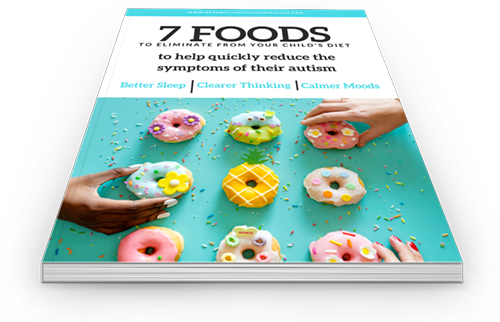What is low vagal tone and why have studies linked it to people with autism spectrum disorders? Learn 5 ways you can easily stimulate the vagus nerve at home, and how it can help both you and your child to improve Digestion, Calming, and Overall Better Health.
The vagus nerve is the longest cranial nerve in the body branching out from the brain to different areas of the body. It not only regulates gut physiology, but is also involved in controlling the cardiovascular, respiratory, immune, digestive, and endocrine systems. It has a tremendous connection with our ability to stay calm. This is because the vagus nerve is intimately connected with the parasympathetic nervous system. Children with autism commonly display symptoms of vagus nerve dysregulation.
Resetting the vagus nerve can help to create what is called vagal calm in the body. The vagus nerve is important to address at the beginning of any detoxification protocol since detoxifying is an additional stressor. The vagus nerve may need to be reset to optimize the autonomous nervous system to eliminate inappropriate fear responses, whether fight or flight, or an immobility shutdown response. This is commonly seen in symptoms such as heart arrhythmias.
Neurodegeneration of the vagus nerve comes from intestinal disorders, environmental toxic exposure, coinfections, inflammation, or any physical or emotional trauma that cause continual stress on the body. The vagus nerve can get stuck in the fight or flight response and create anxiety-like behaviors, as well as depressive ones. It also has to do with our ability to connect to others. This will be discussed a bit later.
Studies show the vagus nerve serves as a bridge between the gut microbiota and the brain.
The microbiome in the gut (good and bad) gets into the vagus nerve and travels to the brain.
The vagus nerve is implicated in studies, “Vagus Nerve and Underlying Impact on the Gut Microbiota-Brain Axis in Behavior and Neurodegenerative Diseases” to be directly impacted by the gut microbiome.
Researchers have now found the gut microbiota and the brain are inextricably linked due to substantial evidence. The gut microbiota-brain axis, regarded as a bridge and link between the gut microbiota and the brain, can be achieved through the neuroanatomical pathways such as vagus nerve (VN) or spinal cord, the neuroendocrine system such as the hypothalamic-pituitary-adrenal axis (HPA axis), and cytokines, as well as direct or indirect chemical pathways that may involve microbial metabolites and some specific neurotransmitters.2,3
Toxins and pathogens in the gut are migrating up to the brain using the vagus nerve. The vagus nerve has many responsibilities, but when it’s disrupted it also causes uncontrollable anxiety, digestive issues, and respiratory problems, to name a few. It’s also implicated in seizures. It is the body’s reaction to these pathogens and toxins that cause the problems.
Additionally, The vagus nerve is implicated as the major factor in the development of Crohn’s or colitis. The vagus nerve is the pathway into the intestinal wall, causing the diseases to develop.
Picky Eating and Hunger Regulation
We know children with autism have issues with food and can be very picky eaters. There are many reasons including, OCD, sensory issues, histamine sensitivity and anxiety around food. Parents often say that their child is not eating enough, or cannot seem to get enough food and is constantly hungry.
I’ve talked in the past about neurotransmitters, or brain messengers, and how serotonin has to do with mood stability, sleep, and appetite satiety. Serotonin is made in the gut and must transfer to the brain. If the gut is not working properly then serotonin cannot be produced in adequate amounts and the brain is deprived of it. This is one of the reasons we see mood instability and heightened behaviors, problems with sleep, and issues of appetite satiety. However, it is also likely to be associated with an imbalance in vagus nerve control.
Vagal Control of Satiety and Hormonal Regulation of Appetite
The vagus nerve has also been shown in studies to affect appetite.
In addition to the hypothalamus, the vagus nerve is critically involved in the control of feeding by transmitting signals arising from the upper gut to the nucleus of the solitary tract. Among the peripheral mediators, cholecystokinin (CCK-a peptide hormone in the gastrointestinal (GI) system that helps digest fat and protein) is the key peptide involved in generating the satiety signal via the vagus. CCK is implicated in the control of food intake, more specifically, the reduction in food intake.
Leptin is the hormone that helps maintain normal body weight. Leptin resistance causes you to feel hungry and eat more even when your body has enough fat. Therefore, leptin and CCK interact synergistically to induce short-term inhibition of food intake and long-term reduction of body weight.
The interaction of these two hormones with the vagus nerve has been shown to reduce short-term food intake. It is conceivable that malfunctioning of these signaling molecules may result in eating disorders.
Studies show ‘Vagus nerve stimulation as a potential adjuvant to behavioral therapy for autism and other neurodevelopmental disorders’
Vagus nerve stimulation (VNS) is an FDA approved therapy that is safe and effective in reducing seizure frequency and duration in individuals with epilepsy. Individuals with neurodevelopmental disorders often exhibit decreased vagal tone, and studies indicate that VNS can be used to overcome an insufficient vagal response. Multiple studies have also documented significant improvements in quality of life after VNS therapy in individuals with neurodevelopmental disorders.
♥
Simple techniques to help stimulate the vagus nerve:
Stimulating the vagus nerve assists many systems and chemicals in the body. It helps the pituitary which is involved in hormonal balance and mood. Furthermore, the stimulation of the vagus nerve assists in increasing the neurotransmitter called oxytocin that influences deeper connection with others, increases trust, helps with sleep, and can help calm anxiety. These are all key symptoms of children with autism.
The vagus nerve can be retrained to regain balance. This takes some time, but with patience and consistency it can happen.
Here are 5 Ways To Stimulate The Vagus Nerve:
1. Massage of the vagus nerve:
The branches of the vagus nerve that you can massage on the head to help stimulate and calm are:
A. At the back of the neck at the base of the occiput (the bone at the lower portion of the back of your head). Massage the soft tissue there, just below the bone.
B. Just behind the ears. I offer a brief tutorial video showing two craniosacral holds you can do for this. You can find the video at, NaturallyRecoveringAutism.com/CS.
2. Tapping Acupressure Points To Assist Emotional Balance: Tapping has been used successfully with war veterans for PTSD, and is used for anxiety, insomnia, depression and even physical pain. The area just below your collarbone on the upper portion of the chest stimulates the vagus nerve. Tap with four fingers, about ten times. There is a post on my website along with a podcast and an image of the tapping points for you at NaturallyRecoveringAutism.com/120.
3. Deep breathing: Breathing is always calming to the nervous system and should not be underestimated in its ability to help calm.
4. Laughter, singing, humming, blowing, teeth clenching (gently) or gargling: Interestingly, the back base of your neck where the occiput meets the soft tissue, as mentioned a moment ago, is one of the areas that is stimulated when we clench our teeth, blow, laugh, sing, and hum. If you place your hand on the back of your neck in this spot and do any of these activities, then you can feel the area move. This movement stimulates the vagus nerve branch there.
5. Exercise: Any movement of the body is beneficial. Do not underestimate the power of exercise for stress reduction. Our kids need to get out of the house, into nature and move their bodies. Pent up adrenaline will build and make it harder to relax. Go burn off some steam!
Additionally, some foods that are good for the vagus nerve are ginger, Himalayan salt, bitters (for digestion and the nervous system), artichoke, and milk thistle.
Of course, we need to be working on all of the underlying triggers such as candida, parasites, Mold biotoxins, Lyme, auto immune issues, toxins of all kinds including heavy metals, food triggers including histamines, and occipital subluxation. Craniosacral therapy and Chiropractic can be helpful for these subluxations.
I can help you work with all of them in a very important sequential order. I’ll be teaching this soon in a free live event so if you’re not already on my email list, please be sure to do that now so that you’re notified when we open up registration. Both my free food guide or my craniosacral video tutorial can do that for you.
Get Your Free Food Guide!
Quickly Reduce Your Child’s Symptoms of Autism by Eliminating 7 Foods Most People Consume Daily!
The first crucial step of autism recovery is to begin restoring health to the gut and the immune system.
The health of the gut is directly linked to the health of the brain and therefore to the symptoms of autism. In fact, 80% of the immune system comes from the gut so if the gut is not healthy, then the brain can’t thrive, and the immune system is compromised. It’s a vicious cycle, but thankfully, it’s one that we can put an end to by first eliminating harmful foods.
- Harmful Foods: Identify the foods that worsen autism symptoms and understand the science behind their impact.
- Smart Food Choices: Learn about easy dietary swaps that can significantly enhance sleep, clarity of thought, and emotional well-being.
- Practical Implementation: Get valuable tips on how to implement these dietary changes easily and effectively.
This is for informational purposes only and is not meant to diagnose or treat. Every child’s level of recovery is different. No two people are the same. It is never implied that all children will have the same outcome. Results are all based on individual biology and the work that is done. This process takes time and various steps, effort and resources need to be weighed. Our programs are intended to help you become more knowledgeable and guide you to help bring your child a better quality of life, whatever that may be. We want to help by giving great content, direction and strategies that move you forward. Nothing on this page or any of our websites is a promise or guarantee of results or future outcomes. The results on this page and any of our websites are not typical or promised. In fact, there will be people who purchase this and other programs and never put the work into implementing the strategies taught and therefore will achieve little to no results. Our more detailed earnings disclaimer, privacy policy, and terms and conditions for this program and website can be accessed via the links below. We hold ourselves (and you) to a high standard of integrity. We are cheering you on every step of the way.












